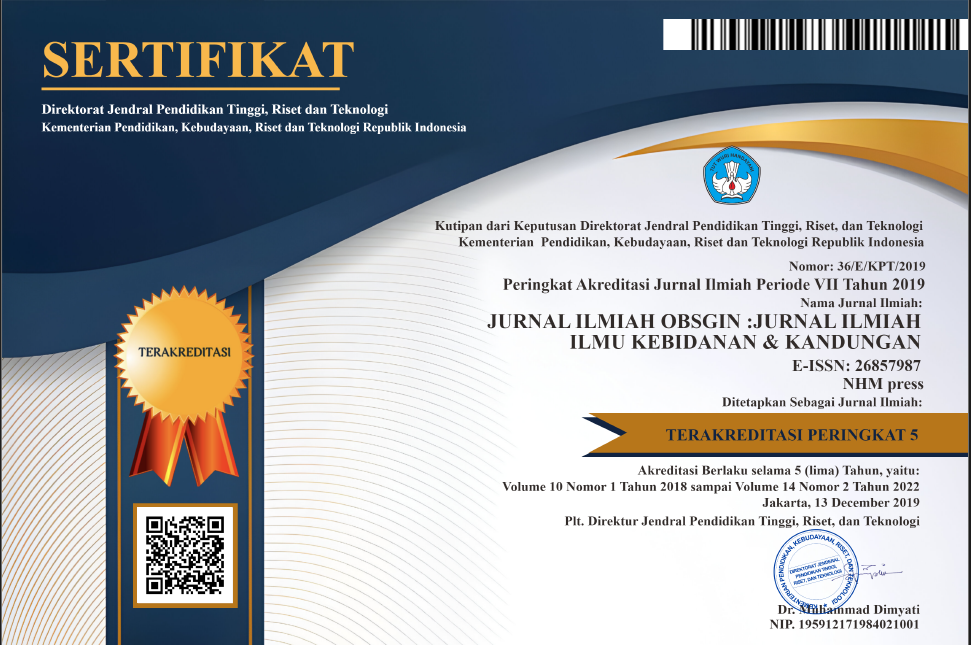FAKTOR-FAKTOR YANG MEMENGARUHI KEJADIAN GIZI BURUK PADA BALITA DIMASA PANDEMIK COVID-19 DI WILAYAH KERJA PUSKESMAS TAWANGA KABUPATEN KONAWE PROVINSI SULAWESI TENGGARA
Abstract
Research Objectives is to determine the factors that influencethe incidence of malnutrition in Toddlers during the Covid-19 Pandemic in the working area of the Tawanga Health Center, Konawe Regency, Southeast Sulawesi Province. This type of research is an observational analytic study withusing a cross sectional study design. The analysis used is univariate, bivariate and multivariate. The sampling technique used is simple random sampling with a sample size of 97 respondents. There is no effect between maternal education and the incidence of malnutrition in children under five(ρValue 0.596 >α = 0.05); There is an influence of mother's knowledge with the incidence of malnutrition in children under five (ρValue = 0.047 <α = 0.05); There is an influence of family income with the incidence of malnutrition in children under five(ρValue = 0.000 <α = 0.05); There is an influence of a history of infectious diseases affecting the incidence of malnutrition in children under five(ρValue = 0.016 <α = 0.05); There is an effect of parenting with the incidence of malnutrition in Toddlers (ρValue = 0.000 <α = 0.05); There is an effect of the number of family members with the incidence of malnutrition in children under five(ρValue = 0.001 <α = 0.05). The results of multivariate analysis showed that the most influential factors with the incidence of malnutrition include income with a significance value of Value 0.000, and the number of family members with a significance value of Value 0.051. There is an influence between knowledge, family income, mother's occupation, history of infectious diseases, parenting patterns and the number of family members with Malnutrition in Toddlers during the Covid-19 Pandemic in the working area of the Tawanga Health Center, Konawe Regency, Southeast Sulawesi Province so that Puskesmas as gate keeper needs to improve education through nutrition counseling programs, and maximize nutrition improvement programs with PMT for toddlers who have underweight nutritional status and increase early detection of groups at high risk of malnutrition.
References
Angkat, A. H. (2018). Penyakit Infeksi dan Praktek Pemberian MP-ASI Terhadap Kejadian Stunting Pada Anak Usia 12-36 Bulan di Kecamatan Simpang Kiri Kota Subulussalam. Jurnal Dunia Gizi. https://doi.org/10.33085/jdg.v1i1.2919
Desyanti, C., & Nindya, T. S. (2017). Hubungan riwayat penyakit diare dan praktik higiene dengan kejadian stunting pada balita usia 24-59 bulan di wilayah kerja Puskesmas Simolawang, Surabaya. Amerta Nutrition, 1(3), 243–251.
Dinkes Konawe. (2019). Profil Dinas Kesehatan Konawe 2019.
Junaid, E. R. A. Z. (2018). Hubungan Pola Makan, Ekonomi Keluarga Dan Riwayat Infeksi Dengan Kejadian Gizi Kurang Pada Balita Diwilayah Kerja Puskesmas Benu-Benua Tahun 2018. Jurnal Ilmiah Mahasiswa Kesehatan Masyarakat.
Kementerian Kesehatan Republik Indonesia. (2015). InfoDATIN : Situasi Kesehatan Anak Balita di Indonesia. Kementerian Kesehatan Republik Indonesia.
Kementerian Kesehatan Republik Indonesia. (2019). Status Gizi Indonesia Alami Perbaikan. Kementrian Kesehatan Republik Indonesia.
Kementerian Kesehatan RI. (2018). Laporan Riskesdas 2018. Laporan Nasional Riskesdas 2018.
Lemewshow, et. al. (n.d.). Besar Sampel dalam penelitian kesehatan (Alih Bahasa). Gadjah Mada University Press.
Lestari, W., Margawati, A., & Rahfiludin, Z. (2014). Faktor risiko stunting pada anak umur 6-24 bulan di kecamatan Penanggalan kota Subulussalam provinsi Aceh. Jurnal Gizi Indonesia (The Indonesian Journal of Nutrition). https://doi.org/10.14710/jgi.3.1.126-134
Mahirawati, V. K. (2014). Faktor-faktor yang berhubungan dengan kekurangan energi kronis (KEK) pada ibu hamil di kecamatan kamoning dan tambelangan, kabupaten sampang jawa timur. Buletin Penelitian Sistem Kesehatan, 17(2), 193–202.
Masniadi, R., Angkasa, M.A.Z., Karmeli, E.,Esabella, E. (2020). Telaah Kritis Ketahanan Pangan Kabupaten Sumbawa Dalam Menghadapi Pandemi Covid-19. Indonesian Journal of Social Sciences and Humanities, 1(2), 109-120.
MIN, S., HOU, L. ling, Hermann, W., HUANG, J. kun, & MU, Y. ying. (2019). The impact of migration on the food consumption and nutrition of left-behind family members: Evidence from a minority mountainous region of southwestern China. Journal of Integrative Agriculture, 18(8), 1780–1792. https://doi.org/10.1016/S2095-3119(19)62588-8
Picauly, I., & Toy, S. M. (2013). ANALISIS DETERMINAN DAN PENGARUH STUNTING TERHADAP PRESTASI BELAJAR ANAK SEKOLAH DI KUPANG DAN SUMBA TIMUR, NTT. Jurnal Gizi Dan Pangan. https://doi.org/10.25182/jgp.2013.8.1.55-62
Pratiwi, F. . (2017). Efektivitas Penggunaan Media Booklet Terhadap Pengetahuan Gizi Seimbang Pada Ibu Balita Gizi Kurang Di Keluarahan Semanggu Kecamatan Pasar Kliwon kota Surakarta. 1–12.
Rachman, B. N., Mustika, I. G., & Kusumawati, I. G. A. W. (2017). Faktor yang berhubungan dengan perilaku konsumsi buah dan sayur siswa SMP di Denpasar. Jurnal Gizi Indonesia (The Indonesian Journal of Nutrition). https://doi.org/10.14710/jgi.6.1.9-16
Rahayu, E. T. (2017). Analisis Pendapatan Usaha Ternak Sapi Perah Di Kecamatan Cepogo Kabupaten Boyolali. Sains Peternakan. https://doi.org/10.20961/sainspet.v11i2.4852
Rangki, Alifariki L.O, H., Rahmawati, R., & Sukurni, Salma, W. . (2020). Risk Factors of Stunting in Children Age 24-59 Months Old. Media Keperawatan Indonesia, 3(1), 10–16.
Reska, Y., Krisnasary, A., & Wahyudi, A. (2018). Tingkat Pendapatan, Kecukupan Energi dan Hidden Hunger dengan Status Gizi Balita. Jurnal Kesehatan. https://doi.org/10.26630/jk.v9i3.1019
Simatupang, M., Herlina, H., Simatupang, R., & Sagala, R. (2019). Association between Maternal Nutrition Awareness and The Risk of Stunting among Children Under Five in Tapanuli, North Sumatera. https://doi.org/10.26911/theicph.2019.03.28
Sri Nengsi, & Risma. (2017). Hubungan Penyakit Infeksi Dengan Status Gizi Balita Di Wilayah Kerja Puskesmas Anreapi Kabupaten Polewali Mandar. Jurnal Kesehatan Masyarakat.
Sundari, S., & Khayati, Y. N. (2020). Analisis Hubungan Tingkat Pengetahuan Ibu Tentang Gizi dengan Status Gizi Balita. Indonesian Journal of Midwifery (IJM).
Suryani, N., Anwar, N., & Wardani, H. (2015). Hubungan Status Ekonomi dengan Konsumsi Buah, Sayur dan Pengetahuan Terhadap Status Gizi pada Siswa SMP di Perkotaan dan Pedesaan di Kotamadya Banjar Baru Tahun 2014. Jurnal Kesehatan Indonesia.
United Nation. (2013). The millennium development goals report 2013.
Wu, W., Takahashi, K., Zhou, L., & Jin, S. (2020). Income inequality and the distributional effects of elevated carbon dioxide on dietary nutrient deficiency. Journal of Cleaner Production. https://doi.org/10.1016/j.jclepro.2020.121606











